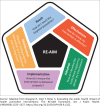Understanding implementation research
- PMID: 40459100
- PMCID: PMC12223990
- DOI: 10.4102/phcfm.v17i2.4934
Understanding implementation research
Abstract
Implementation research (IR) focuses on understanding and closing the gap between evidence-based interventions and practice. Key elements to evaluate include the design of the intervention itself, contextual barriers and enablers to implementation, the use of implementation strategies as well as the achievement of implementation outcomes. This article gives an overview of IR for doctoral-level researchers in the fields of family medicine and primary care. The consolidated framework for IR and socioecological model are considered for making sense of the contextual factors. A typology of implementation strategies is also described to make conceptualisation, reporting and sharing of findings easier. Standard implementation outcomes are described, such as coverage or reach, acceptability, adoption, appropriateness, feasibility, fidelity, costs and sustainability. The RE-AIM framework for implementation outcomes is described. Finally, different study designs are discussed, including hybrid effectiveness-implementation designs and approaches to reporting using the IR logic model.
Keywords: implementation; implementation outcomes; implementation research; implementation strategies; methodology; methods; primary care.
Conflict of interest statement
The authors declare that they have no financial or personal relationships that may have inappropriately influenced them in writing this article. R.M. declares that he is the Editor-in-Chief and Z.M. is a section editor of the
Figures
Similar articles
-
Factors that impact on the use of mechanical ventilation weaning protocols in critically ill adults and children: a qualitative evidence-synthesis.Cochrane Database Syst Rev. 2016 Oct 4;10(10):CD011812. doi: 10.1002/14651858.CD011812.pub2. Cochrane Database Syst Rev. 2016. PMID: 27699783 Free PMC article.
-
Barriers and facilitators to implementation of evidence-based task-sharing mental health interventions in low- and middle-income countries: a systematic review using implementation science frameworks.Implement Sci. 2022 Jan 12;17(1):4. doi: 10.1186/s13012-021-01179-z. Implement Sci. 2022. PMID: 35022081 Free PMC article.
-
Effectiveness of using implementation frameworks to facilitate the implementation of a stroke management guideline in the traditional Chinese medicine hospitals in China: protocol for a factorial randomised controlled trial.BMJ Open. 2025 Jan 28;15(1):e078103. doi: 10.1136/bmjopen-2023-078103. BMJ Open. 2025. PMID: 39880436 Free PMC article.
-
Strategies for enhancing the implementation of school-based policies or practices targeting risk factors for chronic disease.Cochrane Database Syst Rev. 2017 Nov 29;11(11):CD011677. doi: 10.1002/14651858.CD011677.pub2. Cochrane Database Syst Rev. 2017. Update in: Cochrane Database Syst Rev. 2022 Aug 29;8:CD011677. doi: 10.1002/14651858.CD011677.pub3. PMID: 29185627 Free PMC article. Updated.
-
Feasibility and acceptability of community-based psychosocial interventions delivered by nonspecialists for perinatal common mental disorders: A systematic review using an implementation science framework.Glob Ment Health (Camb). 2025 May 26;12:e54. doi: 10.1017/gmh.2025.10010. eCollection 2025. Glob Ment Health (Camb). 2025. PMID: 40556715 Free PMC article. Review.
References
-
- National Science Board . Science and Engineering Indicators [homepage on the Internet]. Alexandria, VA; 2018. [Cited 2025 February 17]. Available from: https://www.nsf.gov/statistics/indicators/
-
- Peters D, Tran N, Adam T. Implementation research in health: A practical guide. Geneva: World Health Organization; 2013.
MeSH terms
LinkOut - more resources
Full Text Sources
Miscellaneous





